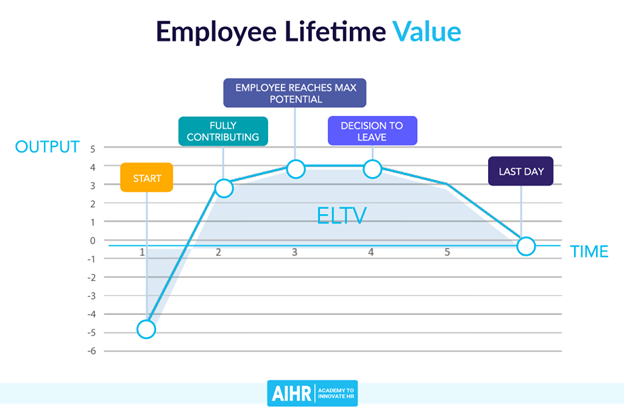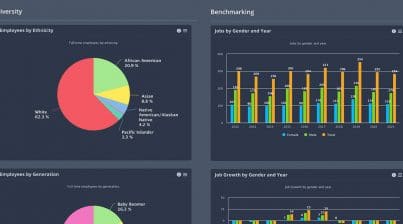How do you measure the true value of your workforce? Can you attribute a dollar amount to employees making customers and team members smile? Or the extra effort put into thoroughly answering a customer’s questions that come in via email? Over the course of your employees’ journey from start to leave, there are moments you can add up that make a lasting impact on your organization: positive customer interactions, innovative ideas, reducing costs, and improving efficiencies. But can you attribute a financial value to them?
The concept of Employee Lifetime Value (ELTV) is fairly new and gives companies a tool to measure those impactful moments throughout the employee experience. Discover first-hand how we can help your organization use HR data to support the measurement of the employee experience with a free trial of EmployeeCycle.
And in this post-pandemic competitive market for talent, ELTV is a tool that will become more important as your organization recruits for new employees.
What is Employee Lifetime Value (ELTV)?
ELTV is a quantitative measure of the long-term contribution an employee makes to your organization over their lifetime with your business. It’s also been referred to as the single measure of ROI for all HR initiatives in an organization. Wow! That’s a lot of importance, so let’s dig a bit deeper.
Why is ELTV Important for HR to Measure?
If you’re like most HR leaders, you have a list of initiatives and programs you’re passionate about implementing at your organization. Why? You believe those efforts will improve hiring times, onboarding, engagement, and retention, to name a few. Have you been able to get executive budget approval for your initiatives? If not, it could be because it’s difficult to prove to your leadership that your initiatives could result in a significant ROI for your organization. Maybe you’ve had to rely on your instinct or HR industry norms, rather than data.
What if you were able to show that hiring, onboarding, professional development/training, and culture initiatives could be proven to strengthen your company and help reach organizational goals? It can be done using HR data and ELTV.
A high ELTV has a positive impact on business outcomes because, as stated above, they bring value to the organization.
The graph shown here shows how to easily interpret ELTV, with the X-axis representing time, the Y-axis representing employee production, and below the curve is ELTV.

Start: the employee’s production is negative because they aren’t doing anything to contribute to the output of the team yet. They are consuming resources from recruiting, hiring, and onboarding.
Fully Contributing: at this point the employee has been trained and ramped up in their role. Now they are becoming an active contributor to the productivity of the team.
Max Potential: this is where the employee’s growth in career, knowledge, and other factors level out. They may start looking for other opportunities outside of the organization.
Decision to Leave: once the employee has made the decision to leave, their focus goes elsewhere. They focus on transitioning to leave, learning about the new position, moving locations, etc. Their productivity reduces drastically.
Last Day: this is when the employee’s productivity comes to a halt.
The area shaded under the line curve is the employee’s ELTV. As HR professionals, part of your responsibility is to make this area as tall and wide as possible in order to maximize the ELTV of each employee.
How Can You Maximize ELTV?
Recognize how an employee’s value can change during their employment and start to implement ways to improve ELTV. Here are some tips:
- Shorten the time between Start and Fully Contributing so that an employee is productive more quickly. This can include how you recruit candidates and how you train them. Are there ways to improve the process used to identify quality talent? Can you streamline your onboarding to get a new hire contributing as quickly as possible?
- Increase how high and wide an employee can grow between Fully Contributing and Max Potential. Consider the management style and culture of your organization. Can you train your managers to be insightful and point out areas of improvement for their employees? Can you empower your managers to provide their teams with the right tools and processes to increase their productivity? Does your culture allow for professional development to improve employee’s skills, allowing them to contribute at a higher level toward your company’s goals?
- Increase the time an employee stays with the company by widening the time between Max Potential and Decision to Leave. The longer an employee stays with your organization, the greater their value will be. This is where you implement retention strategies such as improving benefits plans, increasing scheduling flexibility, and implementing incentive programs.
How Do You Calculate ELTV?
The ELTV calculation can be fairly simple and then improved with more data and complex math. It’s important to remember that the more data you can gather per employee, including their performance, additional productivity, training, innovations, etc. the more accurate your ELTV results will be.
In simple terms, take your company’s average yearly revenue, divide it by the number of employees who contribute to the revenue, and then multiply by the average tenure of an employee. That’s your average ELTV value.
Final Considerations for ELTV
Gathering, monitoring, and analyzing your organization’s ELTV data will lead to strong workforce decisions, and provide a greater ROI. When you provide data and analytics that help decision-makers understand the optimal path for new hires to contribute, it will lead to a more robust culture of employee engagement, productivity, and retention.
ELTV data also provides you with the information that helps make a business case for additional investment into your workforce. When you can showcase the importance of professional development and training, you are able to demonstrate those costs as investments that provide tangible, positive impacts to your organization’s bottom line.
In short, ELTV drives business outcomes, which are measurable as revenue, profit, customer satisfaction, product innovation, lead generation, and much more. Employee development, a focus on employee retention, and a good employee experience are key to increasing employee lifetime value. And, has a positive impact on your organization’s bottom line. Employee Cycle’s ELTV dashboard can make a huge difference in your HR initiatives and the positive outcomes across your organization. Find out how by scheduling a free demo.












